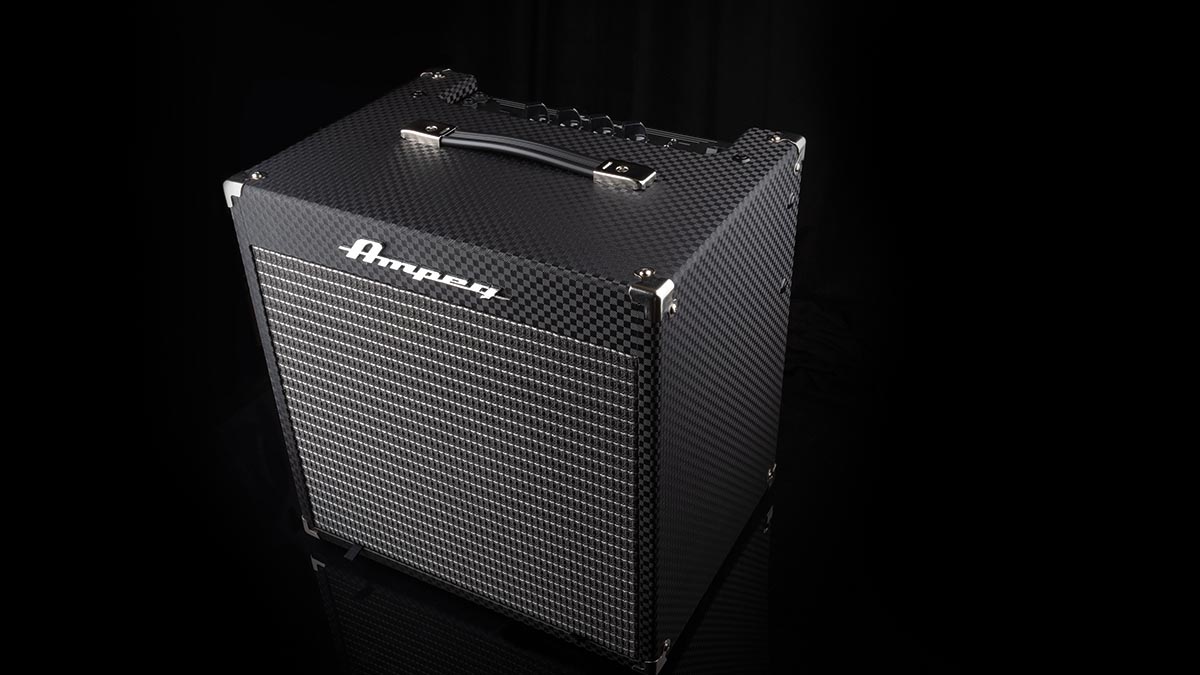Guitar World Verdict
A fine range of new bass amps with something for everyone. These combos naturally tick the usual boxes – portable, reasonably loud, and simple to use, with useful features and functions in a presentable format for home use.
Pros
- +
Usable sounds.
- +
Easy to use.
- +
Very portable.
Cons
- -
Bass projection is limited.
You can trust Guitar World
The new Rocket range of bass amp combos from Ampeg has five models of varying specifications, and all share a vintage, old-school vibe. With a simple but effective control layout, cool styling and all the connections you would expect to see, these combos can be used in a variety of settings and applications.
We’re looking at the 1x8” and 1x10” models which focus on home, rehearsal, and small acoustic gig situations. Let’s see what they can do.
Build Quality
Rated at 30 and 50 watts respectively, both combos are lightweight and portable, aided by their speaker sizes, and both are finished in the ‘black diamond’ material seen on previous Ampeg combos.
Metal corners protect the units from bumps and scrapes, while cloth speaker grilles, a recessed control panel, and a tough carry-handle situated on the upper facing feature on both units. Clearly, these combos have been designed with practicality and simplicity in mind.
Utilizing the Ampeg Legacy preamp, these combos have been additionally furnished with the company’s trademarked SGT (Super Grit Technology) overdrive circuitry, which provides both units with the signature Ampeg grit and drive that we have come to expect, without resorting to tube technology – and thus pushing the price up.
Thankfully, the control panel is well laid out and easy to use, with a simple volume and three-band EQ setup, although the other combos in the range have additional Ultra-Hi and Lo selector switches.
All of the controls are securely attached and turn smoothly with little fuss. The SGT option is accessed via a switch on the control panel, although it can be footswitchable on some of the larger combos; the 1x8 combo is purely ‘effect on/off’, whereas the 110 unit has additional Grit and Level controls to give the player a degree of control.
All the latest guitar news, interviews, lessons, reviews, deals and more, direct to your inbox!
Both combos feature 3.5mm aux in and headphone output sockets, a prerequisite for any home-use combo these days, while the 10” speaker-equipped 110 model also incorporates a balanced XLR DI output for sending a feed to a mixer or audio interface.
Sounds
It’s very apparent that these combos are only going to produce so much low end – and rated at 30 and 50 watts respectively, you won’t be blowing any drum kits away with one of these.
However, placed in the corner of a room or against a wall, you will get the impression that they can produce a fuller and more rounded bass tone than if you were to place either of them in the middle of a room.
With 8” and 10” speakers, the bass signals from each combo are going to have a mid bias. You can’t escape this, because you can’t rewrite physics – a small speaker in a small enclosure just can’t pump out tones that shift air.
Nevertheless, both of these combos put in a respectable performance, with the three-band EQ proving to be impressively flexible. Even without a horn or tweeter, the top end is clear and biting, without creating too much clank, especially from the passive basses I used to test the units with.

Calling on several active basses, both combos managed to keep up with the additional power afforded by the active EQ, but as expected, the 110 combo just had the edge with its larger speaker and enclosure, allowing the signal and tones of each bass to bloom and be slightly more effective in terms of their delivery.
So, onto the SGT circuitry. For a company whose reputation has been firmly built on valve technology, some may see this solid-state ‘valve-flavor’ as a gimmick – but in use, it’s far from that.
With the smaller combo, you may decide never to turn it off, as it gives the tone some added color and character, creating a lively edge that isn’t there otherwise. With the 110 combo, the additional SGT controls mean you can dial in some grit without it taking over the whole tone, instead simply adding some warmth to the overall sound.
Returning both combos to their clean state, turning the volume up gradually, and pushing each unit to its limits, you may be surprised that the pushed delivery won’t take the plaster off the walls – which may or may not be a good thing, depending on your intended use of either combo.
Specs
Ampeg Rocket Bass RB-108
- PRICE: $209 / £139
- MADE IN: China
- POWER: 30 watts @ 4 ohms
- FEATURES: SGT (Super Grit Technology) switch, volume, bass (+13/-21dB@40Hz), midrange (+16/-10dB@500Hz), treble (+12/-16dB@4kHz)
- SPEAKERS: 1 x 8” speaker
- DIMENSIONS: 433mm (H) x 411mm (W) x 306mm (D) / 17.04” (H) x 16.18” (W) x 12.04” (D)
- CONNECTIONS: 1/4” jack inputs x 2 (0/-15dB), 3.5mm Auxiliary input, 3.5mm headphones output
- WEIGHT: 23 lbs
Ampeg Rocket Bass RB-110
- PRICE: $321
- MADE IN: China
- POWER: 50 watts @ 4 ohms
- FEATURES: SGT (Super Grit Technology) switch, grit, level, volume, bass (+14/-20dB@40Hz), midrange (+15/-10dB@500Hz), treble(+12/- 16dB@4kHz), ground/lift switch
- SPEAKERS: 1 x 10” speaker
- DIMENSIONS: 481mm (H) x 411mm (W) x 330mm (D) / 18.93” (H) x 16.18” (W) x 12.99” (D)
- CONNECTIONS: 1/4” jack inputs x 2 (0/-15dB), 3.5mm Auxiliary input, 3.5mm headphones output, balanced XLR DI output
- WEIGHT: 22.5 lbs
- CONTACT: Ampeg
- Save cash with one of the best budget bass amps

